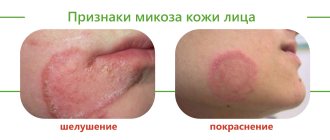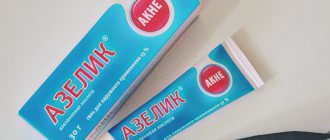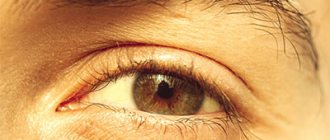Our skin is constantly in contact with a large number of allergens, so skin allergies are one of the most common types.
A group of diseases in which the main symptoms are skin allergies are called allergic dermatoses. These include diseases such as urticaria, allergic contact dermatitis, atopic dermatitis, eczema, toxicerma, etc.
Skin allergies: main causes
There are many reasons for the development of allergic dermatosis: various food allergens, medications, household chemicals, cosmetics, etc.
Skin allergies are caused by:
- Living in regions with unfavorable ecology.
- The presence of occupational hazards (prolonged human contact with aggressive objects: alkalis, acids, smoke, medications, etc.).
- Eating with a large number of allergenic foods.
- High drug load.
- Widespread use of household chemicals containing highly allergenic chemical compounds, dyes and fragrances.
- In young children, skin allergies can be triggered by early cessation of breastfeeding and early introduction of complementary foods.
Risk factors also include a hereditary predisposition to allergic diseases.
In addition, the causes of exacerbation of skin allergies can be diseases of the gastrointestinal tract, stress, etc.
Cost of consultation with a doctor?
| Name of service | Price, rub.) |
| Initial appointment with a dermatologist | 2000 rub. |
| Repeated appointment with a dermatologist | 1500 rub. |
| Primary appointment with an obstetrician-gynecologist | 2000 rub. |
| Repeated appointment with the obstetrician-gynecologist | 1500 rub. |
| Primary appointment with an obstetrician-gynecologist (candidate of medical sciences; doctor of medical sciences) | 2100 rub. |
| Repeated appointment with an obstetrician-gynecologist (candidate of medical sciences; doctor of medical sciences) | 1600 rub. |
| Prescription of treatment (drawing up an individual treatment regimen) | 1500 - 3000 rub. |
All our services and prices
Skin allergies: symptoms
Symptoms of skin allergies may appear immediately after contact with the allergen or after some time (from 10-20 minutes to 1-2 days).
The main signs of skin allergies can be considered:
- rash (can vary significantly with different types of skin allergies);
- redness and swelling of the skin;
- itching, scratching;
- dryness and flaking of the skin.
Scratching may lead to a bacterial or fungal infection, which further aggravates the course of the disease. All this creates severe physical and psychological discomfort, disrupting sleep and affecting ability to work.
Depending on the type of allergic dermatosis, certain signs of skin allergies may be particularly pronounced or, conversely, absent.
Where to sign up for treatment for pustular diseases in Moscow?
At a multidisciplinary medical center you can always sign up for treatment for pustular diseases
. Our medical center is located between the Konkovo and Belyaevo metro stations (South-Western Administrative District of Moscow in the area of the Belyaevo, Konkovo, Teply Stan, Chertanovo, Yasenevo, Sevastopolskaya, New Cheryomushki metro stations " and "Trade Union"). Here you will find highly qualified personnel and the most modern diagnostic equipment. Our clients will be pleasantly surprised by our quite affordable prices.
Brief characteristics of the most common types of skin allergies
Hives
The term “urticaria” unites a whole group of diseases of different nature, but with a similar clinical symptom - blistering-type skin rashes, reminiscent of a nettle burn.
The causes of urticaria are varied. Skin allergies can develop as a result of a reaction to allergens (eg, food, insect bites, medications) or from physical causes such as exposure to the sun, cold, heat and pressure. Hives can be triggered by concomitant diseases of the gastrointestinal tract, endocrine system, or chronic infection.
A typical symptom of urticaria is the appearance of rashes on the skin accompanied by itching. The skin around them may be red. Sometimes all the elements on the affected area of the skin can merge together, forming giant blisters.
The main characteristic of skin allergies is the complete reversibility of blisters: after some time they disappear without a trace, leaving no traces, white spots or scars. But unlike a regular nettle burn, this disease appears again, and with a change in location: today the urticaria was on the legs, and tomorrow it can be found on the arms.
Allergic contact dermatitis
Allergic contact dermatitis is a skin allergy caused by direct exposure to an irritating substance, or allergen.
Most often, contact dermatitis is caused by household chemicals, cosmetics, various chemicals, nickel, latex, and some medications.
Allergic contact dermatitis develops on areas of the skin that have been or are in contact with an allergen.
The first symptoms and signs of contact dermatitis may not develop immediately, but some time after contact with the allergen - several hours, days or even weeks.
The main manifestations of allergic contact dermatitis: redness and swelling of a limited area of the skin that has been in contact with the allergen, severe itching in the area of redness, and the appearance of blisters of various sizes on the skin with a clear liquid inside. When damaged, the bubble bursts and erosion forms in its place. When the skin allergy subsides, yellow crusts remain for some time.
Atopic dermatitis
Atopic dermatitis is a chronic allergic skin disease accompanied by itching and rash. This skin allergy is common in infants and children and usually begins in the first 6 months of life, often continuing into adulthood.
Atopic dermatitis is a multifactorial disease. The leading factor is hereditary predisposition. Food and inhalant allergens play an important role. In childhood, the main food allergens are milk proteins, chicken eggs, fish, and grains. With age, inhalation allergens are added: house dust, animal hair, plant pollen.
Provoking factors for atopic dermatitis can be mechanical, physical or chemical irritants, increased sweating, tobacco smoke, stress, hormonal factors, and infection.
Atopic dermatitis has three sequential forms (infantile, childhood and adult dermatitis), differing in the characteristics of their manifestation.
Any form of atopic dermatitis is characterized by dry skin, itching, thickening of the skin with increased skin pattern, peeling, redness and rashes.
With atopic dermatitis, a vicious circle is formed: itching - scratching - rash - itching. The skin with atopic dermatitis is changed even without an exacerbation. Its structure and water balance are disturbed.
Eczema
Eczema is a chronic recurrent skin disease of allergic origin, characterized by a polymorphic itchy rash (vesicles, erythema, papules). The causes of eczema can be very different, from external factors (chemicals, drugs, food and bacterial allergens) to internal ones.
Exacerbations of this type of skin allergy occur under the influence of psycho-emotional stress, diet disorders, contact with chemicals and other allergens.
Depending on the cause of the appearance and location of the rash, several types of eczema are distinguished: seborrheic, true, occupational, microbial. The areas where the rash is localized tend to itch and peel, causing a lot of inconvenience to the person. Eczema is chronic with periods of exacerbations and remissions, and treatment of skin allergies is often complicated by the addition of pyoderma or herpes. With skin allergies of this type, changes in the functional activity of the digestive tract, metabolic processes, neuroendocrine disorders, and vegetative-vascular dystonia can also be observed.
Toxidermy
Toxidermia is an acute toxic-allergic inflammatory skin lesion, which is an allergic reaction to the introduction into the body (inhalation, ingestion, parenteral administration) of substances with allergenic properties.
The causes of toxicerma are most often drugs and food products.
More often, widespread toxicerma is observed, which is manifested by multiple rashes and itching. Often this type of skin allergy involves the mucous membranes, which may also have various rashes.
In addition to the common one, fixed toxicoderma is possible, in which one or more swollen red spots of round or oval shape appear; in some cases, a bubble may form in the center of each of them. Typically, such skin allergies are associated with taking medications. After the action of the allergen ceases, the inflammatory phenomena subside, and the stain remains for a long time. The most severe forms of toxicerma are Stevens-Johnson syndrome and Lyell's syndrome. They are considered emergencies and require hospitalization.
With a huge variety of allergic dermatoses themselves, there are diseases with similar symptoms. For example, a rash can accompany some infections, diseases of internal organs, etc. Therefore, do not try to diagnose yourself with “skin allergies” and do not self-medicate.
Only a doctor, having collected a detailed history and conducted the necessary examination, will be able to determine the exact cause of the disease and prescribe medications that are suitable in each specific case.
The most common pustular skin diseases
Furuncle
– acute purulent inflammation of the follicle, sebaceous gland and surrounding tissues. The cause of its occurrence is a staphylococcal infection, which begins to become more active when the immune system is disrupted. Cuts, scratches, and scratching of the skin during diseases with itching also contribute to the entry of staphylococci into the body. Most often, boils appear on the face, neck, armpits, thighs and buttocks, chest and lower back. In its development, the formation goes through three stages - infiltration, suppuration, healing. As a result of improper treatment, a boil can cause serious complications such as an abscess or sepsis. Under no circumstances should you squeeze it out yourself! Only a specialist can prescribe the correct treatment regimen. Prevention of complications includes preventing mechanical damage to a mature boil and the spread of infection.
Furunculosis
– necrotic disease of the hair follicle and surrounding tissues with the formation of pus and severe inflammation. The main cause of furunculosis is a staphylococcal infection. Symptoms - at the first stage, the appearance of a small infiltrate and bright red color around the hair follicle, which after a few days affects the adjacent sebaceous gland and surrounding tissues. The purulent core increases in size, and the formation begins to resemble a cone, very painful on palpation. The patient may have a fever and weakness. Acute furunculosis can last up to several months and be accompanied by numerous boils. Complications - rough scars on the skin, possible abscess or phlegmon, sepsis, lymphadenitis. The patient must urgently seek help from a dermatologist, who will prescribe systemic antimicrobial therapy, recommend ointments and diet, and also refer the patient for surgical opening of the abscess.
Erysipelas
– an infectious-inflammatory disease of the skin and subcutaneous tissue, characterized by constant relapses. The main symptoms of erysipelas are the formation of a red swollen area on the body, separated from the healthy area by a raised ridge, fever, weakness, and enlarged local lymph nodes. The disease affects all age groups. The reasons for its occurrence are decreased immunity due to stress or chronic diseases. The basis for the treatment of erysipelas is the use of antibiotics and antibacterial drugs, as well as antihistamines, vitamin-mineral complexes and dietary nutrition. Self-medication is strictly prohibited, as this can lead to death for the patient!
Streptoderma
– an infectious skin lesion caused by streptococcal microorganisms, which is accompanied by the appearance of flaky purulent elements with a diameter of several millimeters to several centimeters. The diagnosis is made by a specialist based on the results of scraping from the affected area and bacteriological culture data. Infection most often occurs through household contact from the patient himself or objects shared with him. Treatment of streptoderma consists of isolating the patient in quarantine for up to 10 days, taking general strengthening and vitamin preparations, antibiotics, treating surfaces with antimicrobial agents, and applying aseptic dressings. It is recommended to follow a hypoallergenic diet and avoid contact with water.
Staphyloderma
– formation of foci of purulent-inflammatory skin lesions caused by staphylococcal infection. The disease can be transmitted through touch or objects used. Symptoms of staphyloderma are increased body temperature, general weakness and lethargy, abscesses. The superficial form of the disease is characterized by the appearance of individual folliculitis - conical pustules with purulent contents in the area of the hair follicle. The deep form is characterized by multiple pustules with significant damage to the skin and a general deterioration in the patient’s condition. Treatment of most forms of superficial staphyloderma consists of the use of antibacterial and antiseptic ointments. In more serious cases, intravenous and intramuscular antibiotics are prescribed, as well as ultraviolet irradiation and other physiotherapeutic techniques.
Sign up for treatment for pustular diseases
Make an appointment











